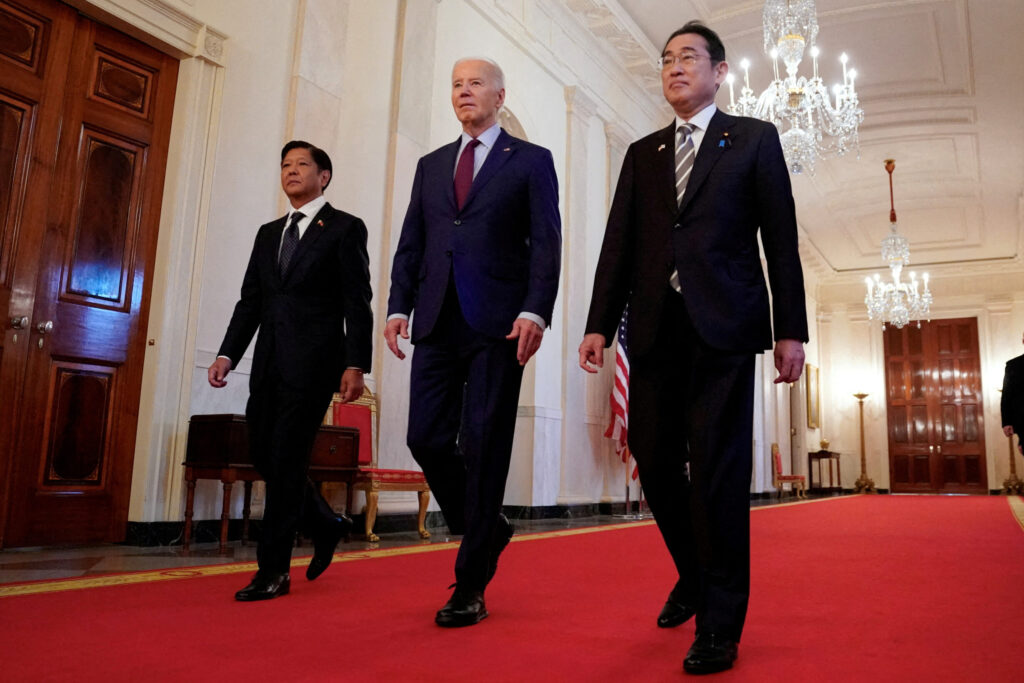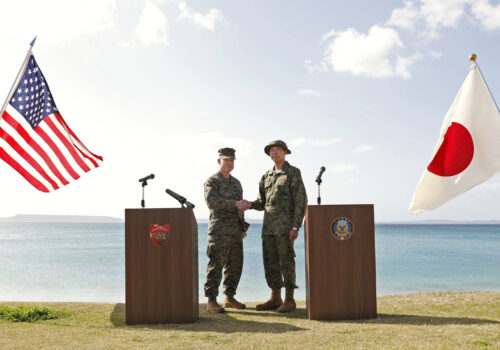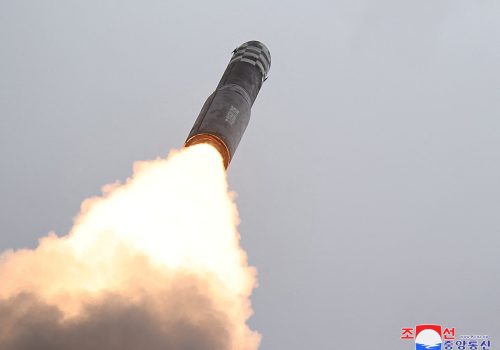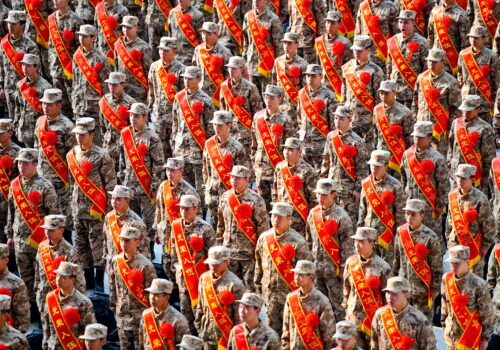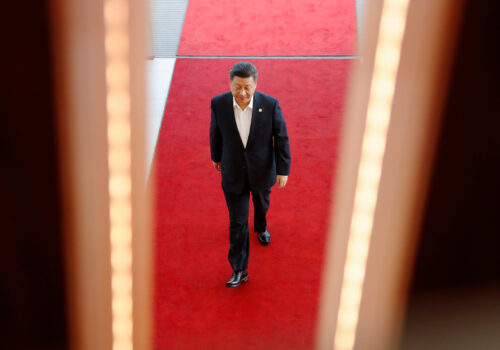Are they reaching for the Moon? This week, US President Joe Biden welcomed Japanese Prime Minister Fumio Kishida to the White House for a state visit and an ambitious agenda. More than seventy agreements were announced, covering everything from upgrading defense cooperation and increasing investment to, yes, launching a lunar mission. Biden announced that a Japanese astronaut will be the first non-American on a future NASA mission to the Moon.
On Thursday, the two leaders joined a third, Philippine President Ferdinand Marcos Jr., for an historic trilateral meeting focused on an earthbound issue: countering Chinese pressure in the South and East China Seas. The “global” partners have undertaken a planet-sized agenda. Can they deliver where it matters most? Below, Atlantic Council experts share their insights.
Click to jump to an expert analysis:
Amy Searight: An innovative set of meetings sends an unmistakable message
Markus Garlauskas: Closer integration of US and Japanese forces will come down to the details
Sarah Bauerle Danzman: Biden seems to have painted himself into a corner with Nippon Steel
Lauren D. Gilbert: A cherry blossom-like alliance adapts as it blooms
An innovative set of meetings sends an unmistakable message
Defense cooperation took center stage in the US-Japan meeting on Wednesday, as Biden and Kishida emphasized the role of the alliance in bolstering the rules-based order in the Indo-Pacific, underscoring the challenge posed by China’s growing maritime assertiveness and military build-up. The two leaders announced a series of upgrades to the US-Japan security alliance that aim to translate the increasingly close strategic alignment between the two countries into a more operationally integrated alliance with enhanced capabilities.
Among the announcements were plans to modernize command-and-control structures to improve communication and planning between US forces based in Japan and their Japanese counterparts, with a vision toward creating a more integrated alliance command in the future. Plans were also announced for jointly producing military equipment, establishing an integrated air- and missile-defense network along with Australia, and integrating Japan into the Australia-United Kingdom-United States (AUKUS) pillar on advanced technology cooperation in areas such as artificial intelligence and autonomous systems.
Kishida’s government has helped lay the groundwork for these alliance upgrades on several fronts. This includes moves to raise Japan’s defense spending to 2 percent of its gross domestic product, the decision to establish a joint operations command, the loosening of restrictions on exporting military equipment to closely aligned countries, the acquisition of long-range strike capabilities, and passage of the Economic Security Promotion Act to protect information security on sensitive technologies.
As impressive as these initiatives on defense cooperation are, the most innovative and perhaps significant part of Kishida’s visit will occur on Thursday when Biden and Kishida are joined by Marcos in a first-ever US-Japan-Philippines Trilateral Leaders’ Summit. The overriding symbolic message of the summit will be the image of the three leaders standing shoulder to shoulder in solidarity in the face of China’s intensifying maritime coercion. As recently as March, China harassed Philippine vessels attempting to resupply a garrison on the Second Thomas Shoal outpost in the South China Sea. These kinds of “gray zone” tactics by China call for more than a narrow military response, which elevates the need for alliance coordination across diplomatic, security, and even economic arenas.
Discussions on maritime security cooperation will build on the strong defense ties the Philippines has with both countries. Tokyo has entered into a new era of defense cooperation with Manila, including negotiations on a reciprocal troop access agreement. Meanwhile, the United States has also deepened defense ties with the Philippines under Marcos, adding four new Enhanced Defense Cooperation Agreement sites and committing one hundred million dollars in additional military funding. The promise of this new trilateral format lies in coordinating even more closely on maritime capacity building efforts and other security activities in order to signal resolve and strengthen deterrence against Chinese aggression.
Surprisingly—and disappointingly—absent from the summit outcomes are initiatives aimed at strengthening supply chains in critical minerals such as nickel, a major export of the Philippines and an essential material for electric vehicle battery production. The Philippines would like to position itself as a hub for processing critical minerals and move up the value chain to producing components, but discussion of a critical minerals agreement with the Philippines appears off the table for now. It’s a missed opportunity.
—Amy Searight is a nonresident senior fellow in the Atlantic Council’s Indo-Pacific Security Initiative and a former deputy assistant US secretary of defense for South and Southeast Asia.
Closer integration of US and Japanese forces will come down to the details
“This is the most significant upgrade in our alliance since it was first established,” Biden said on Wednesday. This upgrade, as the Financial Times reported in March, includes a plan to “restructure the US military command in Japan to strengthen operational planning and exercises between the nations.” Some speculate that this change will even involve upgrading US Forces Japan (USFJ) to a four-star command, like US Forces Korea, in part to allow the USFJ commander to be of equivalent rank to Japan’s joint operations commander. Whatever form it ultimately takes, a more “operationalized” headquarters in Japan will benefit not only the US-Japan alliance, but also US military capabilities and posture in the western Indo-Pacific.
Though such Japanese and US operational headquarters will improve the ability to employ Japanese and US forces, the new structures must also ensure that US and Japanese forces can more effectively work together to deter aggression and fight alongside each other if necessary. Whether or not their commanders are ultimately four-star level officers, it is still unclear how these two headquarters will work together and what overarching structure will connect them. What is clear is that the US headquarters in Japan will not have authority over the Japan Joint Operations Command. James Schoff, a scholar with the Sasakawa Peace Foundation USA and former Pentagon official, notes that though measures should be taken for “bilateral planning and coordination,” it is “legally and politically impossible” for Japan’s Self Defense Forces to come under US command.
One model for closer integration would be a bilateral command with US and Japanese officers working side by side. The US-South Korea alliance has long had a well-established structure for wartime command and control under a single Combined Forces Command headquarters staffed with US and South Korean military officers commanded by a US four-star general, which conducts bilateral military planning and regular major bilateral exercises. This command is going through a transition itself, under plans to prepare for a South Korean officer to take command of alliance forces in wartime. Though some elements might be taken from this model, it has its own limitations and may not be realistic for the US-Japan alliance.
Schoff—along with Chris Johnstone, another former Pentagon official with deep expertise on Japanese defense issues—recently assessed that parallel structures with separate US and Japanese chains of command will be legally and politically necessary, and argued in favor of a co-located joint, bilateral planning and coordination office to connect these structures. Though this may be pragmatic, it is hardly optimal from an operational perspective. US military doctrine for multinational operations notes that “because of the absence of a single commander, the use of a parallel command structure should be avoided, if at all possible.”
Whatever form these new arrangements ultimately take, they will have to address the Japanese command-and-control component and the future structure of US Forces Japan.
—Markus Garlauskas is the director of the Indo-Pacific Security Initiative at the Scowcroft Center for Strategy and Security. He is a former senior US government official with two decades of experience as an intelligence officer and strategist, with twelve years stationed overseas in the region, including five years as the chief strategist for the US-South Korea Combined Forces Command. Read more below from Garlauskas:
The US is driving security cooperation in the Indo-Pacific, but it needs to do more on economic security
Increasing aggression from China in the South China Sea and elsewhere is clearly pushing the United States and its Indo-Pacific allies and partners into a closer embrace on matters of security. It has brought Japan and South Korea together, informed Indonesia’s increases in defense spending, and is one impetus behind the Australia-United Kingdom-United States (AUKUS) agreement.
Biden’s trilateral summit on Thursday with Kishida and Marcos, which will codify important security–related deliverables, is further evidence of increasing pushback on China’s threatening behavior. Growing cooperation between the three nations, as evidenced through military exercises that took place last week, is a welcome addition to the proliferating “minilateral” architecture that has emerged in part to maintain a free and open Indo-Pacific.
With that said, the United States needs to do more on the economic front, especially in Southeast Asia, where economic and security matters are seen as joined at the hip for many in the region. The Indo-Pacific Economic Framework (IPEF), launched in 2022, was a step in the right direction, but it leaves much to be desired. This is especially true regarding market access, which is what many countries in the region want. If this doesn’t change, China will continue to gain influence at the expense of the United States.
Ultimately, the US approach to trade reflects domestic political difficulties around the issue. It’s naïve to expect much, if any, progress during a presidential election year, as it is a vexing issue in key swing states that may decide the election—just look at where the pushback on Nippon Steel’s proposed acquisition of US Steel is coming from. For those hoping for progress, don’t get your hopes up before November.
—Parker Novak is a nonresident fellow with the Atlantic Council’s Global China Hub and Indo-Pacific Security Initiative, where he specializes in Southeast Asia, the Pacific Islands, Indo-Pacific geopolitics, and US foreign policy.
Biden seems to have painted himself into a corner with Nippon Steel
Toward the end of Wednesday’s joint press conference, which was designed to communicate a strong and further strengthening economic, political, and military alliance between the United States and Japan, Biden said “I am a man of my word, and I will keep my commitment to American workers.” He further added that he would likewise keep his commitments to US allies.
But what happens when these two desires—to deliver for specific (and electorally important) workers and to strengthen ties with a strategically important ally—are at odds?
Nippon Steel’s bid to acquire US Steel, which I’ve previously written about here, nicely illustrates this quandary. Nippon’s proposed acquisition of US Steel would help upgrade aging technology, increase efficiency, and expand US-based job opportunities in the domestic steel industry. It also would send a strong signal that the United States remains committed to an open, rules-based economic system with reasonable guardrails for national security considerations. This commitment to a free and open Indo-Pacific is vital to an island nation such as Japan and a core refrain of bilateral meetings.
At the same time, US steel workers and the unions that represent them do not trust that a foreign owner—even from an allied nation—will be a good-faith bargaining partner in future contract negotiations. In an effort to stop the transaction, a growing chorus of politicians, competitors, and labor leaders have argued that a Japanese firm owning a US-based steel firm generates a national security risk. As the transaction undergoes a reported review by the Committee on Foreign Investment in the United States (CFIUS), Biden has publicly stated his opposition to the transaction.
Threading the needle of being responsive to labor demands while also fostering “friendshoring” and strengthening economic ties with trusted partners is going to be difficult. Biden seems to have painted himself into a corner. However, one bright spot emerging from the press conference is that, at least in this engagement, Biden has backed away from rhetoric that this deal harms national security and instead has focused on commitments to workers. It’s unclear what kind of authorities the administration would have to block a deal in the absence of an identified national security risk, since CFIUS is only empowered to recommend action if such a risk is found. But it’s much better for the long-term relationship if US officials are candid to partners about their motivations.
Nippon/US Steel isn’t a national security issue—it’s a labor issue compounded by swing-state politics in an election year. It’s good for the administration to be honest about this so that when it does make claims of national security concerns, allies and partners are more apt to believe it.
—Sarah Bauerle Danzman is a resident senior fellow with the GeoEconomics Center’s Economic Statecraft Initiative. She is also an associate professor of international studies at Indiana University Bloomington where she specializes in the political economy of international investment and finance.
The leaders’ meetings should be seen in light of broader and ongoing military cooperation
US engagement with Japan and the Philippines this week in Washington is a welcome development. Japan is a linchpin of US security interests in the Indo-Pacific. Kishida’s visit is timely and demonstrates growing political will to advance a range of defense initiatives in the region. Recurrent and increasingly sophisticated Chinese provocations are prompting the United States and its allies and partners to take additional defense measures to improve military force posture and readiness.
US and Japanese military forces are increasingly training and operating together to deny China’s military terrain through the establishment of combat-credible forces west of the International Date Line. In autumn 2023, about 3,500 US and Japanese soldiers participated in the Orient Shield ‘23 exercise to improve interoperability. This winter’s Keen Edge ‘24, a computer simulation, rehearsed crisis response actions. Keen Edge is part of an annual exercise that includes field training. Notably, press reports note that China was named as the exercise’s adversary for the first time, rather than a hypothetical enemy.
Both Japan and the Philippines are key to higher degrees of readiness that are necessary for a rapid response in any military contingency. This week’s national policy conversations follow the first-ever trilateral conference among commanders of land forces from the United States, Japan, and the Philippines, which occurred in late 2022 in Tokyo.
Multilateral alignment in the national security realm will no doubt buttress a range of ongoing US military programs. One of the most prominent is Operation Pathways, a key operational approach that builds readiness and strengthens interoperability between US and partner forces through habitual training and planning.
Pathways and its associated events take the form of extended-duration exercises that demonstrate to local populations (and to the Chinese military) the long reach of the US Joint Force. The establishment of command-and-control nodes, higher-fidelity collection assets, and the positioning of sustainment capabilities are also underway.
While air and maritime forces receive much of the attention when US officials view the Asia-Pacific theater, it is worth remembering that seven of the world’s ten largest armies call the Indo-Pacific region home. And the majority of the region’s militaries consist of land forces. Landpower will play a prominent role in any regional military contest.
While US forces have long been stationed in Japan, collaboration is now happening in the Philippines as well, to bolster Philippine defenses amid disputes with China in the South China Sea. Salaknib ‘24, a major annual bilateral exercise, kicked off this week. Balikatan ‘24, which occurs in several weeks and will involve around 16,000 US and Philippine forces, will exercise Manila’s new comprehensive archipelagic defense concept.
In June, around two thousand US and Philippine army forces will conduct combat-simulated, force-on-force drills in the Philippines at Manila’s request. Among the countries sending observers will be Japan.
—Major General Brad Gericke, US Army (ret.), is a nonresident senior fellow in the Indo-Pacific Security Initiative at the Atlantic Council’s Scowcroft Center for Strategy and Security.
A cherry blossom-like alliance adapts as it blooms
The National Park Service recently announced that it will cut down more than one hundred of Washington’s cherry blossom trees originally gifted from Japan as part of repairs to the seawall in the Tidal Basin area, news that has saddened many Americans. In light of this and the Biden-Kishida summit, Japan has gifted the United States 250 new cherry blossom trees to be planted in the US capital. This is an apt metaphor for the US-Japan alliance in this new globalized world. The two countries are adapting to the current global situation and providing each other with invaluable support. And they are creating new opportunities that wouldn’t have been possible had they stayed tied to the past. Nowhere can this trend be more clearly seen than in the defense aspects of the US-Japan alliance.
Kishida is leading a Japan that is taking a strong position on not only the security environment in the Indo-Pacific, but also that of the larger world. Kishida’s administration has taken important steps to increase the Japanese defense budget, create counterstrike capabilities to enhance deterrence, and assist Ukraine. These strong initiatives are set to continue, as seen in the Joint Leaders’ Statement, with changes in force posture, command-and-control structures, air and missile defense, and more.
All of this shows Japan’s dedication to maintaining a free and open Indo-Pacific and a world order based on freedom and prosperity. The past two years have shown the world that it is past the age where countries can focus only on their own borders or regions. Japan, in particular, has taken this lesson to heart, and it is showing undeniable leadership in this difficult global security environment.
As Kishida said on Wednesday, “I am confident that the cherry blossom–like bond of the Japan-US alliance will continue to grow even thicker and stronger here, in the Indo-Pacific, and in all corners of the world.” The challenge now, especially with elections upcoming, is to use that confidence to institutionalize and build on the initiatives for deeper cooperation that the leaders announced this week.
—Lauren D. Gilbert is a deputy director with the Atlantic Council’s Indo-Pacific Security Initiative housed within the Scowcroft Center for Strategy and Security.
In Tokyo and Seoul, the summits were met with mostly optimism, with some caveats
It was illuminating to watch the reaction to Kishida and Marcos meeting with Biden this week from Japan and South Korea. We were participating in a South Korea, Japan, and United States Trilateral Women in Security delegation, sponsored by the US State Department. As leaders were meeting in Washington, we were in Tokyo and Seoul for a series of discussions with officials and observers.
The optimism surrounding the blossoming cooperation in Washington was palpable. Many of the announced plans to improve cooperation were welcomed, as was the sense that there is growing regional alignment on the threat posed by China. However, there were also notable caveats to this optimism.
First, Japan and the United States are moving to increase Japan’s involvement in maintaining regional stability through the building of regional partnership capacities, particularly in areas where the United States has less access and influence. However, there are limitations to Japan’s role in the region. For instance, as many of the experts pointed out to us this week, it is unlikely that Japan will join US-led Freedom of Navigation Operations in the near term. Furthermore, there were earlier reports that the US-Japan alliance was working toward formulating operational plans to implement in the event that the alliance needs to come to the defense of Taiwan. However, we did not observe any indication that there has been any significant movement toward this effort.
Second, there was a lot of discussion surrounding shifts to command-and-control mechanisms in the Japan-US alliance. Japan announced that it will create a permanent joint headquarters to centralize the command and control of its joint operations. At the same time, the United States announced that it will look at its approach to command and control in Japan. These shifts in command and control in Japan are expected to improve parallel cooperation, particularly amid crises. Some observers have compared this development in the Japan-US alliance with what is already in place in the South Korea-US alliance. However, as some experts we talked with in Japan explained, it is unlikely to be identical to the combined command-and-control structure in the Japan-US alliance due to the limitations imposed by Japan’s constitution.
In addition, at the national strategic level, the Japan-US and the Japan-Philippines-US summits revealed two important implications for South Korea experts. First, these summits that deepen the “latticework” in the region will create a positive environment to sustain the “Spirit of Camp David,” regardless of volatility surrounding election results in any of these countries’ respective capitals. Second, South Korea will likely now feel encouraged to increase its role and scope in this latticework.
During his time leading US Forces Korea, General Robert “Abe” Abrams emphasized that his command must never take the relationship with South Korea for granted, noting that trust must be maintained and strengthened every single day. This is a valuable maxim, and given mounting concerns about China’s efforts to reshape the region’s trajectory in its interests, it is one that should be extended to cooperation within and among regional US alliances. Hopefully, this week’s summits will only result in more cooperation within the US network of alliances.
—Jessica Taylor is a nonresident fellow in the Scowcroft Center’s Indo-Pacific Security Initiative. Taylor has served in the US Department of Defense in both military and civil service capacities for nearly twenty years.
—Bee Yun Jo is a nonresident senior fellow in the Indo-Pacific Security Initiative at the Atlantic Council’s Scowcroft Center for Strategy and Security and an associate research fellow in the Defense Strategy Division at the Center for Security and Strategy at the Korea Institute for Defense Analyses.
Further reading
Wed, Aug 16, 2023
The United States and its allies must be ready to deter a two-front war and nuclear attacks in East Asia
Report By Markus Garlauskas
This report highlights two emerging and interrelated deterrence challenges in East Asia with grave risks to US national security: 1) Horizontal escalation of a conflict with China or North Korea into simultaneous conflict; 2) Vertical escalation to a limited nuclear attack by either or both adversaries to avoid conceding.
Tue, Mar 19, 2024
There will be no ‘short, sharp’ war. A fight between the US and China would likely go on for years.
New Atlanticist By Brian Kerg
US policymakers and military leaders must rigorously study and plan for a broad range of implications from a years-long war against China.
Wed, Apr 3, 2024
In the Pacific Islands, US delay is an invitation for China to step in
New Atlanticist By William Piekos
China’s recent efforts to lure Pacific Island governments into alignment with Beijing’s policy preferences heighten the importance of a consistent US focus on the region.
Image: US President Joe Biden escorts Philippines President Ferdinand Marcos Jr. and Japan Prime Minister Fumio Kishida to their trilateral summit at the White House in Washington, U.S., April 11, 2024. REUTERS/Kevin Lamarque
